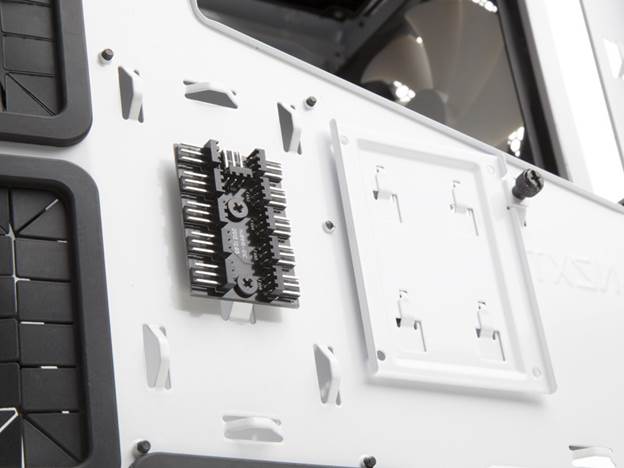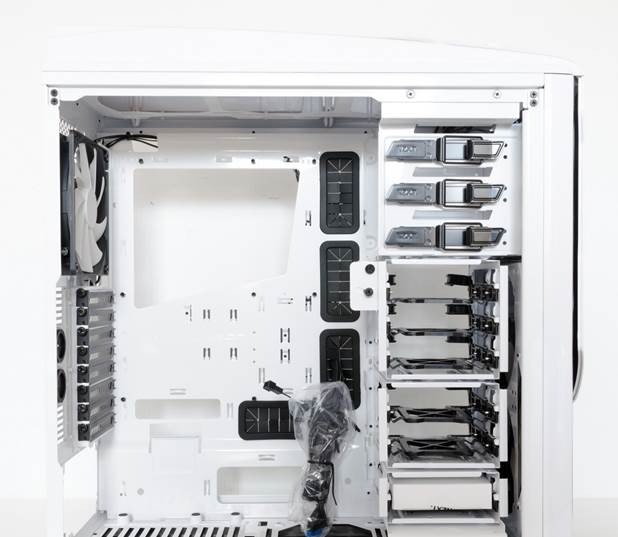NZXT Phantom 530 – Shiny Case
No skull ring, but a very shiny case
with room to move and some great features.
In the past when we’ve looked at NZXT
products, they’ve had a distinctly... budget feel. They’ve always been nearly
perfectly adequate, but simply unable to compete with the monsters of case
design such as Corsair and Silverstone. The Phantom range, while large, may not
be all perfect, and even this - arguably our favourite – has a little way to go
to really compete, but it’s certainly a very pleasant surprise.

Continuing the legacy of the original,
the new Phantom was meticulously designed
from the ground up for a refreshing new design that is uncompromising in every
way.
The first thing which is kind of amazing
is that despite boasting a very high-gloss finish, we don’t hate it! Some tech
that comes to us in over-shiny form simply ends up accruing so much obvious
hand-gunk that it’s soon distinctly unpleasant to even look at, but the
Phantom’s glossy-coating is impressively gunk-resistant.
Which means you can simply enjoy the
rather striking finish. It even comes in three colours - white, black, and a
very fetching red.
The external design is likewise striking,
with a single, slightly bevelled panel embracing the front upper edge, above
black mesh filter material to the back rear and the lower front. The left
sidepanel has a window and another, slightly more curious mesh-panel (there are
no fan mounts, but it would be useful if you mount a radiator for liquid
cooling nearby) inset. The right-hand panel is plain. If it’s not mesh, it’s
glossy; even the backplate is nice and shiny.

While creating the Phantom 530, the NZXT
design team
painstakingly took every beloved aspect of the original and made it even better
The glossy front fascia is in fact a door
panel, magnetically-locked, and swinging this away reveals the external drive
bays - probably more than most people need, but handy for enthusiasts who want
to have temperature displays or fan control panels on show.
The shiny fun continues inside, too. It’s
not quite as glossy, but it’s certainly not matte, and it is definitely very
roomy. There’s a generous cutout on the motherboard plate for attaching and
detaching CPU coolers, and a lot of room for shuffling cables politely out of
the way for maximum airflow. It’s also very modular. Not only does it have a
similarly useful HDD cage system that can be swapped out or re-arranged, but
even the PSU bracket can be moved backward and forward to suit your build.
The drive caddies all open to the right-hand
side of the case, which is an odd choice, admittedly - this means all the
cabling mounted to the rear of each drive has to be then tracked back to the
motherboard, which could be messy. Each caddy can also fit either a normal HDD,
or an SSD, and there’s another hidden SSD slot on the back of the motherboard
plate, and the mounting points all feature a rubber grommet to damp down
platter noise and vibration. Also back here is a very neat fan hub, so that any
extra fans you install can all be controlled by the fan controller on the top
of the case itself. There are ten inputs, four of which are already taken.

The Phantom 530 introduces 2013 features
to its signature design,
including fully modular hard drive cages
All up it’s an impressive effort from a
manufacturer we’ve often looked down on in the past. The gloss finish and high
design will not be for everyone, but if you want a PC case that breaks clear of
the pack on looks, and has some unique features to boot, this Phantom packs a
punch.
|
Specifications:
·
Drive Bays: External 5.25" x 3, Internal
3.5" /2.5": 6, Internal 2.5": 1 + 6
·
Cooling System: Front 2x140mm/ 120mm or
1x200mm (1 x 200mm
included), Rear 1x140mm (included) / 120mm, Bottom 2x120mm, Side
1x140mm, Top 2x200mm/ 140mm or 3x120mm, Interior
1x120mm/140mm
·
Dimensions: 235mm x 572mm x 543mm
·
Motherboard Support: ITX, Micro-ATX, ATX, EATX
(322x272mm)
|